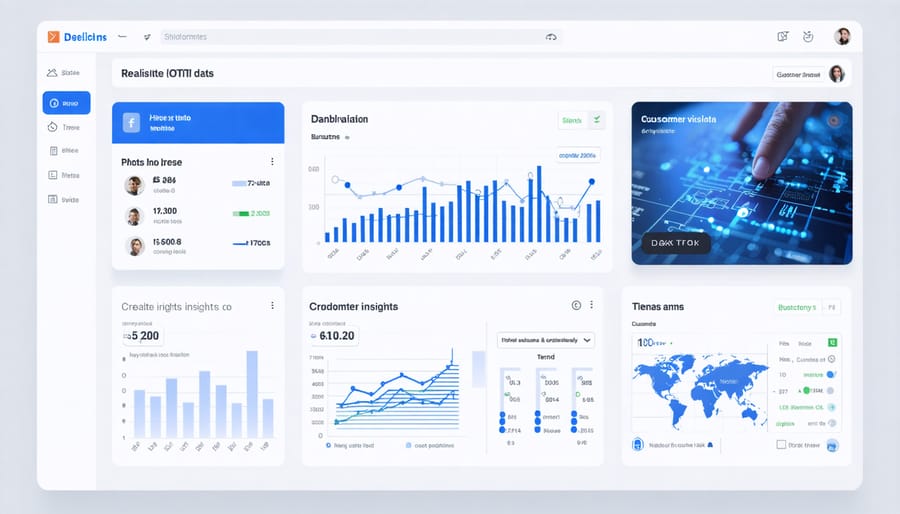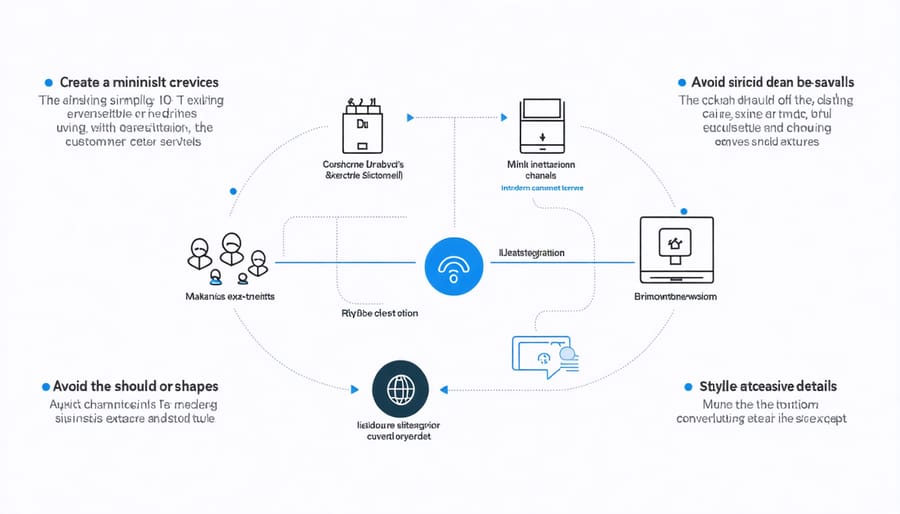IoT Sensors Are Revolutionizing How Companies Listen to Customers

In today’s hyperconnected business landscape, Internet of Things (IoT) technology is revolutionizing customer service by transforming traditional support models into intelligent, predictive systems. Smart devices and sensors now enable businesses to anticipate customer needs before issues arise, dramatically reducing response times and improving satisfaction rates. From automated ticketing systems that instantly route concerns to the right department, to IoT-enabled products that self-diagnose and report problems, companies are leveraging connected technology to deliver unprecedented levels of service.
Research shows that organizations implementing IoT-driven customer service solutions see up to 40% reduction in support costs and a 30% increase in customer satisfaction scores. This shift towards proactive support not only enhances the customer experience but also provides valuable data insights that help businesses optimize their products and services in real-time.
As we enter an era where customer expectations continue to rise, integrating IoT into customer service strategies isn’t just an option—it’s becoming essential for maintaining competitive advantage and building lasting customer relationships.
Real-Time Customer Feedback Through IoT Devices

Smart Sensors and Customer Interaction Points
Smart sensors and IoT-enabled devices have revolutionized how businesses collect and respond to customer feedback. From interactive kiosks to smart displays, these touchpoints help transform customer experience through real-time data collection and automated responses.
Key interaction points include smart shopping carts that track purchase patterns, digital signage that adapts content based on customer behavior, and environment sensors that monitor store conditions. Beacon technology enables personalized mobile notifications when customers enter specific areas, while smart shelves provide instant inventory updates and product information.
Voice-activated assistants and chatbots serve as always-available customer service representatives, handling routine inquiries and collecting valuable feedback. Smart cameras with facial recognition capabilities help analyze customer traffic patterns and emotional responses, enabling businesses to optimize store layouts and service delivery.
These IoT touchpoints create a seamless feedback loop, allowing businesses to gather insights continuously without disrupting the customer journey. The data collected helps identify pain points, predict customer needs, and deliver proactive solutions before issues escalate.
Automated Data Collection Systems
IoT-enabled data collection systems revolutionize how businesses gather and process customer feedback. These automated systems continuously monitor customer interactions, device usage patterns, and service performance metrics without requiring manual intervention. Smart sensors and connected devices capture real-time data points across multiple touchpoints, from in-store experiences to product usage at home.
The automation process typically works in three stages: data capture, processing, and analysis. IoT devices collect information through various sensors, while integrated systems automatically categorize and sort this data into meaningful segments. Advanced analytics tools then process this information to generate actionable insights, helping businesses understand customer preferences and pain points more effectively.
This automated approach offers several advantages over traditional feedback methods. It eliminates human error in data collection, provides continuous real-time monitoring, and captures authentic customer behavior rather than stated preferences. The system can also trigger immediate alerts when it detects service issues or unusual patterns, enabling proactive customer support.
By implementing automated data collection systems, businesses can maintain consistent service quality while reducing operational costs and improving response times to customer needs.
Converting IoT Data into Actionable Customer Insights
Data Analytics and Pattern Recognition
In today’s data-driven business landscape, IoT devices generate vast amounts of customer interaction data that can be transformed into actionable insights. By implementing sophisticated predictive analytics systems, businesses can process this feedback to identify patterns in customer behavior and service preferences.
Modern IoT analytics platforms typically focus on three key areas: real-time monitoring, historical trend analysis, and customer journey mapping. Real-time monitoring allows businesses to detect and respond to service issues immediately, while historical analysis helps identify recurring patterns that may affect customer satisfaction. Customer journey mapping provides insights into how customers interact with products and services across multiple touchpoints.
To effectively process IoT feedback data, businesses should:
– Establish clear metrics for measuring customer interaction
– Implement automated data collection and sorting systems
– Use machine learning algorithms to identify meaningful patterns
– Create automated response protocols for common issues
– Regularly review and adjust analysis parameters
The patterns revealed through IoT data analysis often lead to proactive service improvements, such as predictive maintenance schedules, personalized customer experiences, and optimized resource allocation. This data-driven approach helps businesses reduce response times, prevent service interruptions, and create more targeted customer service strategies that directly address customer needs and preferences.

Predictive Customer Service Models
IoT devices generate vast amounts of customer interaction data, enabling businesses to build sophisticated predictive service models that anticipate customer needs before they arise. By analyzing patterns in device usage, maintenance requirements, and customer behavior, companies can shift from reactive to proactive customer service strategies.
These predictive models work by collecting real-time data from connected devices, such as usage patterns, performance metrics, and environmental conditions. When combined with AI-driven customer personalization, this information helps identify potential issues before they impact customer experience.
For example, smart appliance manufacturers can detect when parts are likely to fail and schedule maintenance visits preemptively. Similarly, software companies can identify usage patterns that indicate a customer might need additional support or training, allowing customer service teams to reach out proactively.
Key benefits of predictive customer service models include:
– Reduced customer complaints through early intervention
– Lower support costs by preventing major issues
– Increased customer satisfaction through proactive engagement
– More efficient resource allocation for service teams
– Higher customer retention rates
To implement effective predictive models, businesses should focus on:
1. Collecting relevant IoT data points
2. Establishing clear threshold triggers
3. Creating automated response protocols
4. Training service teams on predictive insights
5. Regularly refining prediction accuracy
This approach transforms customer service from a cost center into a strategic advantage, delivering value through prevention rather than resolution.
Implementing IoT Feedback Systems Successfully
Integration with Existing Customer Service Channels
Integrating IoT feedback systems with existing customer service channels requires a strategic approach to ensure seamless operation. Begin by mapping your current customer touchpoints, including help desk software, CRM systems, and communication platforms. Create a centralized dashboard that aggregates data from both IoT devices and traditional channels to provide a unified view of customer interactions.
Implement API connections between your IoT platforms and existing service tools to enable automated data sharing. Set up triggers that route IoT-generated alerts to appropriate service teams based on predefined rules. For instance, when a connected device detects an issue, the system should automatically create a ticket in your help desk system and notify relevant staff.
Establish a clear protocol for prioritizing and handling different types of feedback. IoT-generated alerts might require immediate attention, while traditional customer inquiries follow standard response times. Train your customer service team to interpret IoT data alongside conventional customer communications, ensuring they can provide informed responses regardless of the channel.
Regular review and optimization of this integrated system will help identify bottlenecks and improve overall service delivery. Monitor key metrics across all channels to maintain consistent service quality and response times.

Privacy and Security Considerations
When implementing IoT solutions in customer service, data protection and security must be a top priority. Businesses need to establish robust security protocols to protect both customer information and operational data collected through IoT devices. This includes implementing end-to-end encryption for all data transmissions, regularly updating security measures, and ensuring compliance with relevant data protection regulations like GDPR and CCPA.
To maintain customer trust, businesses should be transparent about their data collection practices and provide clear opt-in/opt-out options. It’s essential to inform customers about what data is being collected, how it’s being used, and what measures are in place to protect their privacy.
Regular security audits and vulnerability assessments help identify potential risks before they become problems. Companies should also have a clear incident response plan in case of data breaches or security incidents. Additionally, staff training on data protection best practices ensures that human error doesn’t compromise the security of IoT systems.
Consider implementing role-based access control to limit data accessibility to authorized personnel only, and regularly backup critical data to prevent loss in case of system failures.
Measuring ROI and Success Metrics
To effectively measure the success of IoT implementation in customer service, businesses should focus on specific key performance indicators (KPIs) that directly reflect customer satisfaction and operational efficiency. Customer response time reduction is a primary metric, with successful implementations typically showing a 25-40% improvement in resolution speeds.
Key metrics to track include first-contact resolution rates, customer satisfaction scores (CSAT), and the Net Promoter Score (NPS). IoT-enabled systems should demonstrate measurable improvements in these areas within the first three to six months of deployment. Device uptime and connectivity rates should maintain at least 99% reliability to ensure consistent service delivery.
Cost-effectiveness can be measured through reduced service calls, decreased maintenance expenses, and lower customer churn rates. Successful IoT implementations often show a 15-30% reduction in operational costs within the first year. Additionally, track the number of predictive maintenance interventions and their success rates in preventing customer issues.
Monitor customer engagement metrics such as self-service usage rates and automated resolution success rates. Effective IoT systems typically achieve a 40-60% increase in successful self-service interactions, significantly reducing support team workload while maintaining high customer satisfaction levels.
The integration of IoT in customer feedback systems represents a transformative shift in how businesses understand and respond to their customers’ needs. By leveraging connected devices and real-time data collection, companies can now capture authentic customer experiences at unprecedented scale and accuracy. This automated approach not only streamlines feedback collection but also enables businesses to identify and address issues before they escalate into major concerns.
Looking ahead, the future of IoT in customer service appears increasingly promising. As technologies continue to evolve, we can expect to see more sophisticated integration between IoT devices and customer relationship management systems, leading to even more personalized and proactive service delivery. Machine learning algorithms will become more adept at predicting customer needs based on IoT-gathered data, allowing businesses to stay one step ahead of customer expectations.
The benefits of implementing IoT-driven customer feedback systems are clear: reduced response times, improved service accuracy, decreased operational costs, and heightened customer satisfaction. For businesses willing to embrace this technology, the rewards include stronger customer relationships, increased loyalty, and a competitive edge in an increasingly digital marketplace.
To remain competitive, businesses should begin planning their IoT integration strategy now, focusing on scalable solutions that can grow with their customer base and adapt to emerging technologies. The investment in IoT-enabled customer feedback systems today will undoubtedly pay dividends in the form of enhanced customer experiences and operational efficiency tomorrow.
Leave a Reply